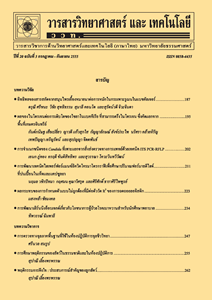การพัฒนาเลิร์นนิงอ็อบเจกต์เกี่ยวกับโภชนาการผู้ป่วยโรคเบาหวานสำหรับนักศึกษาพยาบาล
Main Article Content
Abstract
บทคัดย่อ
การวิจัยครั้งนี้มีวัตถุประสงค์เพื่อ (1) พัฒนาเลิร์นนิงอ็อบเจกต์เกี่ยวกับโภชนาการผู้ป่วยโรคเบาหวาน (2) ศึกษาผลสัมฤทธิ์ทางการเรียนจากการเรียนการสอนด้วยสื่อเลิร์นนิงอ็อบเจกต์ และ (3) ศึกษาความพึงพอใจที่มีต่อสื่อเลิร์นนิงอ็อบเจกต์เกี่ยวกับโภชนาการผู้ป่วยโรคเบาหวานสำหรับนักศึกษาพยาบาล โดยกลุ่มตัวอย่างที่ใช้ในการวิจัยคือนักศึกษาพยาบาล ชั้นปีที่ 1 วิทยาลัยพยาบาลบรมราชชนนี สระบุรี เครื่องมือที่ใช้ในการทดลองและเก็บข้อมูลในการวิจัยครั้งนี้ ประกอบด้วยเลิร์นนิงอ็อบเจกต์เกี่ยวกับโภชนาการผู้ป่วยโรคเบาหวาน จำนวน 30 คน แบบทดสอบวัดผลสัมฤทธิ์ทางการเรียนและแบบประเมินความพึงพอใจที่มีต่อสื่อเลิร์นนิงอ็อบเจกต์เป็นเครื่องมือในการทดลองและเก็บข้อมูล สถิติเชิงพรรณนาและสถิติทดสอบค่าที ได้แก่ ค่าเฉลี่ย ค่าร้อยละ ส่วนเบี่ยงเบนมาตรฐาน ค่าความเชื่อมั่น และสถิติที่ใช้ทดสอบสมมติฐานและหาประสิทธิภาพโดยใช้ค่า E1/E2 และวิธีการทางสถิติ t-test dependent samples ผลการวิจัยพบว่า (1) เลิร์นนิงอ็อบเจกต์เกี่ยวกับโภชนาการผู้ป่วยโรคเบาหวานมีประสิทธิภาพเท่ากับ 91.11/93.17 ซึ่งสูงกว่าเกณฑ์ที่กำหนด (90/90) (2) ผลสัมฤทธิ์ทางการเรียนก่อนเรียนและหลังเรียนพบว่าค่าเฉลี่ยของคะแนนหลังเรียนมีค่าสูงกว่าก่อนเรียนอย่างมีนัยสำคัญทางสถิติที่ระดับ 0.05 และ(3) ผลประเมินความพึงพอใจที่มีต่อเลิร์นนิงอ็อบเจกต์อยู่ในระดับมากที่สุด โดยมีค่าเฉลี่ยเท่ากับ 3.83
คำสำคัญ : เลิร์นนิงอ็อบเจกต์; นักศึกษาพยาบาล; โภชนาการผู้ป่วยโรคเบาหวาน
Abstract
The objectives of this research were (1) to develop learning objects on nutrition for diabetic patients with undergraduate nursing students; (2) to identify learning achievement of undergraduate nursing students studying with learning objects on nutrition for diabetic patients; and (3) to study the undergraduate nursing student satisfaction of learning objects on nutrition for diabetic patients. The sample was thirty first year nursing students at Boromarajonani Nursing College in Saraburi Province. The instruments used in the study were (1) learning objects on nutritional calculation for diabetic patients; (2) an achievement test to compare the pre-test and post-test scores of the undergraduate nursing students studying with learning objects on nutrition for diabetic patients; and (3) a questionnaire on student satisfaction on learning objects on nutritional calculation for diabetic patients. Using descript statistic and dependent sample t-test. The results were presented as follows: (1) The efficiency of the learning objects on nutrition for diabetic patients was 91.11/93.17 which was higher than the criteria of 90/90; (2) The learning achievement of the undergraduate nursing students after studying with learning objects on nutrition for diabetic patients measured by the posttest scores was significantly higher than the pre-test scores at the 0.05 level of significance; and (3) The overall level of undergraduate nursing students’ satisfaction on learning objects on nutrition for diabetic patients was highest with the average score of 3.83.
Keywords: learning objects; undergraduate nursing students; nutrition for diabetic patients


